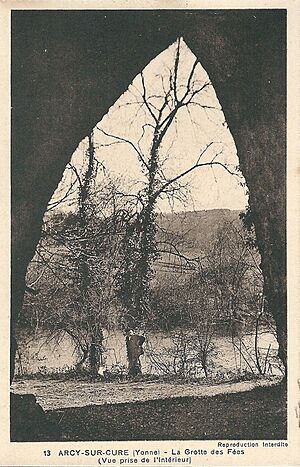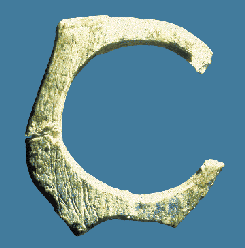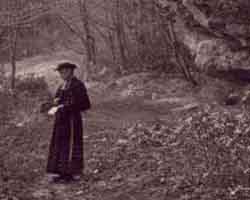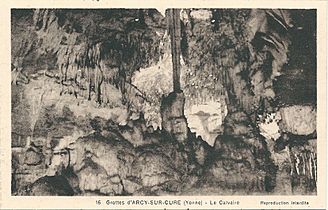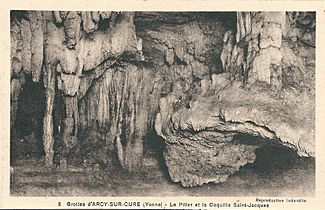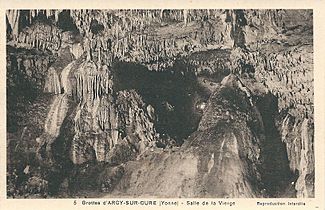Caves of Arcy-sur-Cure facts for kids
Quick facts for kids Caves of Arcy-sur-Cure |
|
|---|---|
fr:Grottes d'Arcy-sur-Cure |
|
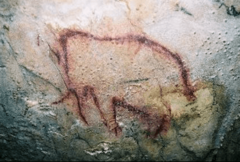
Mammoth in Arcy-sur-Cure
|
|
| Location | Arcy-sur-Cure, Yonne, Burgundy, France |
| Discovery | ancient |
| Geology | Jurassic limestone |
| Features | Decorated caves. Listed Heritage Monument (1992) |
| Website | http://www.grottes-arcy.net/ |
The Caves of Arcy-sur-Cure are a group of amazing caves in Burgundy, France. They are found near the town of Arcy-sur-Cure. These caves are very special because they hold many clues about ancient times.
Inside, archaeologists have found old tools and items. These show that people lived here from the Mousterian period (a time when Neanderthals lived) all the way to Gallo-Roman times.
Some of the caves also have incredible parietal art. This means there are ancient paintings on the cave walls. These paintings are the second oldest known in the world. Only the Chauvet Cave has older art. Another cool thing about these caves is the ancient pollen found. This pollen helps scientists understand what the environment was like long ago.
Between 1947 and 1963, two French experts, Arlette and André Leroi-Gourhan, studied the caves. In 1992, the caves were named a monument historique. This means they are a protected heritage site. Parts of the caves are open for people to visit.
Contents
Where are the Arcy-sur-Cure Caves?
Arcy-sur-Cure is about 30 kilometers (19 miles) southeast of Auxerre. The caves are located about 1.3 kilometers (0.8 miles) south of Arcy-sur-Cure. They are on the left side of the Cure River. The river has carved its way through the limestone rock over many years. This created a valley with tall cliffs, some as high as 125 meters (410 feet).
The caves are found along about 800 meters (2,600 feet) of the valley side. They are at different heights. Most of them face south. The valley walls here are very steep, almost like cliffs.
People have lived in these caves for a very long time. First, there were early humans from the Lower Palaeolithic period. Then, Neanderthals lived here during the Middle Palaeolithic. They even built round huts supported by mammoth tusks! Later, modern humans like the Aurignacians and Magdalenians used the caves. People continued to live here until the Middle Ages.
The caves are owned by Mr. Gabriel de la Varende. He has always supported archaeological research there. One cave used to have two entrances. But one entrance closed when the underground water flow decreased. Now, this cave has pools formed by limestone deposits. The caves also have several lakes inside.
What Caves Can You Find Here?
There are fifteen different caves and shelters in this area. They are all at different heights and sizes. Each one has its own unique features. Here are some of them:
- Great cave
- Lagopède shelter
- Horse cave (about 60 meters or 200 feet long)
- Hyena cave
- Trilobite cave (named after a trilobite fossil found there)
- Bear cave (grotte de l'Ours)
- Reindeer cave (grotte du Renne)
- Schoepflin gallery
- Bison cave (grotte du Bison)
- Wolf cave (grotte du Loup)
- Lion cave (grotte du Lion)
- Fairies cave (grotte des Fées)
- Two Flows cave (grotte des Deux Cours)
- Small shelter, Large shelter (Petit abri, Grand abri)
- Goulettes cave (grotte des Goulettes)
Amazing Cave Art: Prehistoric Paintings
Ancient cave paintings were found in the Great cave in 1990. They were hidden under a thin layer of lime. But some animal drawings, like mammoths in the Horse cave, were known as early as 1946.
Sadly, some paintings were damaged between 1976 and 1990. People used high-pressure water to clean the cave walls. They did not know that prehistoric art was hidden under layers of dirt and lime. They thought it was just smoke from old torches.
The paintings are found deep inside the caves, about 300 to 500 meters (980 to 1,640 feet) from the entrance. The oldest paintings are about 28,000 years old. Scientists used radiocarbon dating on charcoal found nearby to figure this out. This makes them the second oldest cave paintings after the Chauvet Cave (31,000 years old). They are much older than the famous Lascaux paintings (15,000 to 18,000 years old).
However, the Arcy caves have fewer paintings. There are about 160 here, compared to over 400 in Chauvet and 1,900 in Lascaux.
The artists used ochre (a natural earth pigment) and charcoal to create their art. They drew hands of men, women, and children. They also drew many animals.
The hands are "negative hands." This means the artists put their hand on the wall and sprayed paint around it. This left an outline of the hand. We know that at least one hand was drawn using a special tool like a pipette.
When drawing animals, early humans often used the natural bumps and shapes on the cave walls. These shapes would look like parts of an animal, like an eye or antlers, when lit by flickering torches. The artists would then only draw the parts that the wall didn't already show. Usually, only the outline of the animals was drawn.
A special feature of the Arcy cave paintings is that the animals' feet are often drawn "open." They are usually shown with one leg forward and one leg back. Some of the most interesting paintings include a full mammoth and a giant prehistoric stag. This stag, called a Megaloceros giganteus, could have had antlers 4 meters (13 feet) tall! Other animals like bears and woolly rhinoceroses also appear in the art.
Cave Formations: Stalagmites and Stalactites
The lowest parts of the caves often fill with water. Here, you can see amazing cave formations called stalagmites and stalactites. Stalactites hang down from the ceiling, and stalagmites grow up from the floor. When they meet, they form columns. There are also beautiful draperies (like stone curtains) and a special area called the Virgin's room.
One of the lakes has a strange thing happening. Limestone deposits form on the water's surface. They then fall to the bottom and sometimes float back up. Scientists are still trying to understand this.
Stalactites in these caves grow about 1 centimeter (0.4 inches) every 100 years. This shows how slowly these natural wonders form.
It's interesting that some engraved figures on the walls have no limestone deposits on them. But just inches away, thick deposits can grow very quickly. The Horse cave is a good example of this.
Cave Animals: Bats
The caves are home to at least five different kinds of bats. To protect these bats, a new shelter was made for them. Access to this area is now closed to visitors.
A Look Back in Time: History of the Caves
People started digging and studying the caves in the mid-1800s. The first owner, the Marquis de Vibraye, began excavations in the Fairies cave. Later, Abbé Parat studied the main layers of rock and soil in the caves. From 1946, Professor Leroy-Gourand and his team worked in the Hyena cave, Reindeer cave, Bison cave, and Lagopede cave.
The Cure River carved these caves out of limestone rock. Humans have used them as shelters for at least 200,000 years. The oldest signs of human life are stone tools. They were found deep in the Hyena cave. These tools belonged to Neanderthals from the Mousterian period (the middle part of the Old Stone Age). Along with the tools, bones of hippos, beavers, and land tortoises were found.
Later, during the Riss glaciation (a cold period), there were not many tools found. During a warmer time between two ice ages, the river flooded the Hyena cave. But people still lived there sometimes. They left behind a thick layer of deposits. Sand in the Reindeer cave is thought to be from the same time.
After this, the caves had many tools from the Mousterian period. Some human bones, like parts of jaws, were also found.
Then came a very wet period with lots of floods. The river level rose, flooding the lower caves and eroding the higher ones. Water also seeped through the cave ceilings. This brought in older sediments and mixed up the pollen samples. For example, some tropical fern pollen from the Secondary era was found between two Mousterian layers.
After this very damp time, many more Mousterian layers were found. These were especially rich in the Reindeer cave, Bison cave, and Schoepflin gallery.
The Reindeer cave has the largest collection of items from the Châtelperronian period. It is famous for its tools and art made from bone and ivory.
Nearby Places to Explore
About 1,500 meters (4,900 feet) upriver, on the right side of the Cure, is the Cora site. This large area (25 hectares or 62 acres) was home to people about 6,000 years ago. It was a Neolithic village, then a fortified Gaul village, and later a Gallo-Roman fort.
Near the Cora site, there are other caves like those at Arcy. They were also used by humans over 200,000 years ago. You can also find the Saint-Moré spring, an old quarry for sarcophagi (stone coffins), and a Roman villa. The Saint-Moré spring was once considered a holy place. Many people visited it.
The Via Agrippa, an ancient Roman road, passed about 1 kilometer (0.6 miles) west of the caves. It crossed the Cure River at the Noère ford. Today, there are three discovery paths at the Cora camp. They have signs with information about the Gallo-Roman fort that guarded the Roman road.
The GR footpath no. 13 passes right along the top of the cliffs above the Arcy-sur-Cure caves. This long hiking trail connects Fontainebleau to Bourbon-Lancy.
Gallery
See also
Related articles




